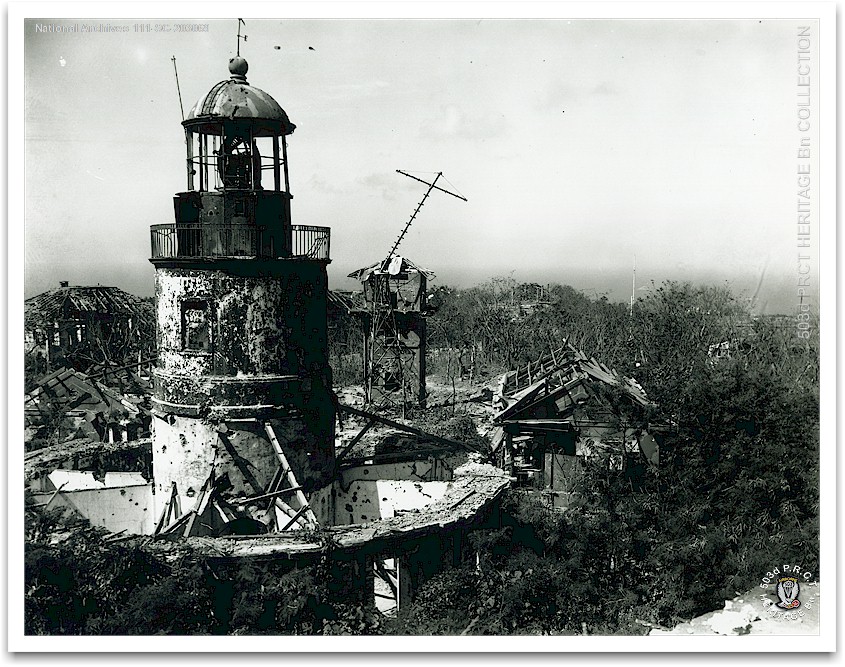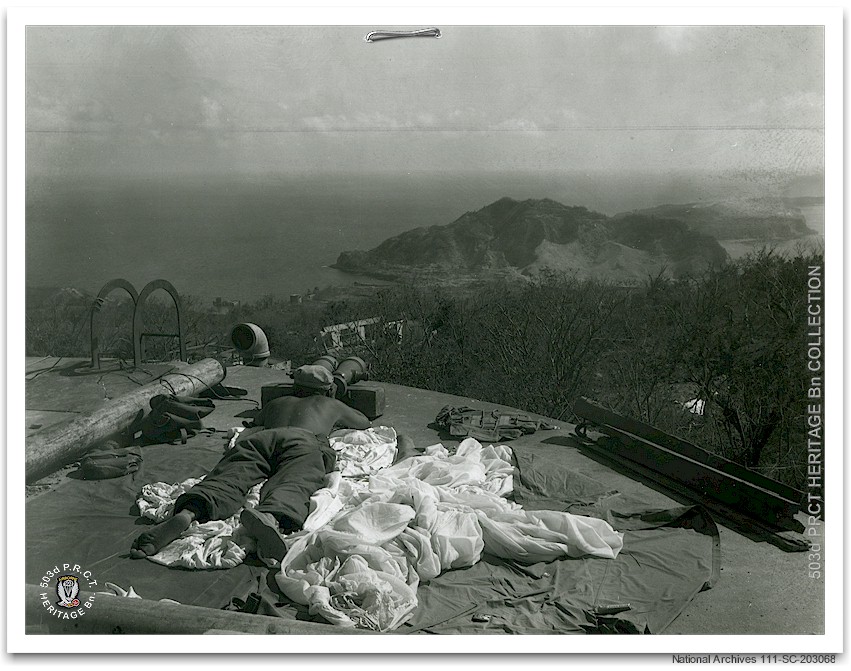23 February 1945 -
Day 8

|
|
|
The S-3's Periodic Report No. 8 fails to report accurately the actions
taking place this day. Partly because of this, there are at least three
articles dealing with the E Company attack on Battery Monja on 23
February 1945, and thereby a controversy arises.
|

No. 8
221800I February 45
to
231800I February 45 |
"3.
OUR
OPERATIONS:
a.
Infantry: Situation at end of of period 231800I- mopping up pro4A ' in
WHEELER POINT, SEARCHLIGHT POINT area has nearly cleared western sector of
ROCK od enemy. Our forces are in position to begin assault on eastern sector
240730I. Combined Air, Naval, Artillery and Ground action will be utilized.
Softening up of area by air, naval and Artillery continues today."
"c.
Aviation: Our planes bombed and strafed the area east of MALINTA HILL to
Airstrip. Thirty One P-47's used in the morning strike, expending 4000
gal�lons Napon, 35 hundred pounds bombs, 31,000 rounds .50 cal. Area
adjacent to Eng. Point was bombed and P-47's continued to strafe.
d. Naval:
The Navy continued to blast caves and areas on WHEELER POINT prior to
Infantry clearing the area; also continued shelling of MALINTA HILL to Air‑
strip
sectors'"
"f.
Signal:
The
Naval and Air Liaison Parties (JASCO and SAP) continued
to provide the essential communications for coordinated. Air, Naval, and
Ground activities."
"4.
CASUALTIES:
a.
Our
Casualties:
This report- 17 KIA, 31 WIA, 10 MIA
To Date- 118 KIA, 314 WIA, 25 IIA, 197 JIIA, 10 MIA.
b.
Enemy Known
Casualties:
This Report-
157 KIA, 2 Pws.
To
Date- 2486 KIA, 6 Pws.
|
|
|
|
|
The 118 KIA above is wrong. Templeman's "Return to Corregidor" list 169
KIA for the entire operation. This seems to be correct. The 50th
Airborne Anniversary book lists 163 KIA, but this book is wrong here and
in numerous other accounts. There were about 54 men killed in the great
explosion at Monkey Point 26 February.
54 and
118 do not, obviously, add up to 169. At least 5 more men were killed in
the 2d Battalion after this date and probably additional men were killed
in other battalions.
PR
No. 8
further
illustrates the danger of using Periodic Reports, of themselves, as the
basis upon which to write historical accounts.
|
|

#101 0800 |
Plans
being made for the assaulting of the eastern part of the island. Col.
Jones, Maj Clarke, Sgt Peterson reconnoitering the area throughout the
day and aboard the destroyer to coordinate naval and air strikes. Area
subjected to strafing & bombing - also naval shelling most of the day.
1st Bn moved down to beach in preparation for attack 24 Feb 45. |
|
#102
1800 |
2nd Bn
reports the patrolling and clearing of area between Searchlight Point &
Wheeler Point. Strong resistance along the coast line and killed 106
daps. Also strong concentration on Wheeler Point and planned Navy
assaulting at 240800I. "E" Co met all resistance. |
|
#102
1800 |
3rd Bn-
I Co patrolled area south from San Jose to Breakwater Point. no contacts
- H Co patrolled battery point area - searching caves. G Co
patrolled Refrig area and cleaned out two snipers hindering road line to
beach. |
|
#103
1900 |
Maj
Clark returned and plans are set for assaulting of area east of Malinta
tunnels beginning at 0830 hour. 3rd Bn 34th Inf to move in after air &
naval barrage and secure area of Malinta tunnels and set up guarding
entrances to all tunnels. 1st |
|
#104
2400 |
Nite
very quiet. No reported activity. Visits by Corp CO and other high
ranking officers. See S-1 Journal. |
|
#105 -
#109 |
short
messages sent and received which are of no interest. |
|
|
|
 |
The
remainder of the evening passed by uneventfully but for the usual
artillery fire. The same perimeter was set up. A battery of 75's was set
up on the parade ground firing in the direction of Malinta Tunnel. Our
2nd Bn is getting new sectors to cover. "E" Company this morning is
sweeping thru from Searchlight Point to Breakwater Point. The 1st and
3rd Bn are to sweep thru the narrow end of the island. There's also a
rumor that the 503 will take over the job of cleaning out the Malinta
Tunnel. This morning there are tractors and cranes working on the parade
grounds. P-47's are again hammering at Malinta Tunnel." [Note the
mistake made in E Company's mission. Their mission was to sweep west
along South Shore Road from Searchlight Point to Wheeler Point.
Breakwater Point was in the opposite direction from Searchlight Point.
As has been pointed out: all eyes were to the east.] |
|
|
|
 |
"The company took
over the job of cleaning out the area between Searchlight and Wheeler
Points. Although we could not clean out all resistance because of an
ammunition shortage, we killed approximately 120 Japs. 2nd Lt. Ball;
Pfc's Robinson and Jandro KIA. Pfc Brown, W.A., was wounded and later
died of those wounds." |
|
Don Abbott, as Executive Officer of E
Co., was called upon to write the E Company History upon returning to
Mindoro. This was only a few weeks after the Corregidor operation,
and the document was intended to be a historical document.
|
|
|
|
 |
"The company is
leaving to take over "B" Co's area and patrol between Searchlight and
Wheeler Points. When the company reached Searchlight Point, the third
platoon was sent down to the beach while the second platoon stayed on
the road. While advancing on unnamed point the second platoon killed
three or four Nips hidden under some vehicles along the road. The third
platoon began to advance to unnamed point and ran into a cave at water
level. They killed 47 Japs and had no casualties. Pvt Robinson was
killed on the point by a sniper. The second platoon advanced on Wheeler
Point along the road to the tunnel entrance. While just a short
distance from the tunnel entrance they came under fire. White phosphorus
grenades were thrown into the entrance and a large number of Nips ran
out so we could mow them down. The snipers began to fire at us from
small tunnels on three different sides. Our ammunition was running low
so we had to withdraw. Pvt. Jandro and Lt. Ball were KIA. Pfc Brown
was seriously WIA. We estimated the Company killed between one hundred
and a hundred and twenty Japs." |
|
|
|
|
What truly occurred on
23 February 1945 has been prepared in consultation with the troopers
actually present along the South Shore Road on that fateful day.
It is an example of how the books got it wrong.
"E" Company Attack on Battery
Monja,
23 February 1945
 |
|
|
|
 |
No Entry |
|
|
|
 |
After a good night's rest we set out for Grubbs Ravine
early the next morning. The company CP was again set up on Way Hill and
each platoon given
a sector to patrol. My area was Battery Smith and Battery Sunset. I sent
one squad to investigate the railroad tunnel which entered Battery Smith
Magazine on the east. This was a large concrete tunnel with rails
running into the magazine. There were steel rings set in the walls.
(Forty-two years later I found out that these rings were there to hold
steel cot frames for the crew to sleep when they were on alert.) There
were openings to the outside about every 50 yards. I believe this was
our 1st squad who searched the tunnel. I sent another squad to search
the big magazine coming in from the west entrance. I believe the second
squad was set up as security on top of the magazine.
The west entrance led into
a large room. On the floor of this room were a large number of knapsacks
laid out side by side in rows as if the wearers had stood there in
ranks, removed their knapsacks and laid them at their feet. These
knapsacks continued on down the tunnel into complete darkness, stacked
on tall cans of black powder, or as Richard Lampman said "large bins
like we used to store oats and wheat on the farm." We had no flashlights
and were not about to take fire in there. Battery Wheeler was still
fresh on our minds. We soon found that these knapsacks belonged to
Special Naval Land Forces (SNLF -- marines, or commonly called Imperial
Marines). The knapsacks contained clothing, prayer saches with stiching
which appeared to be a tiger, hence the name "Tiger Marines" which were
supposedly Japan's best fighting troops-- at least they were the most
fanatical. Also, in the knapsacks were post cards, snapshots, personal
battle flags, prayers in small fabric envelope with a string to tie them
around the neck, naval insignia, invasion pesos, a few invasion
"dollars", opium pellets, small opium pipes (bamboo shaft with metal
bowl); group pictures made at different ages beginning with young boys
in blue uniforms and holding wooden rifles, next teenagers, finally
grown men in uniform and holding rifles; eye glasses, pictures of
Japanese actresses (pin-up girls fully clothed), diaries, and other
personal belongings.
It is very probable
that some of the Japs who attacked us the third night had left their
knapsacks in the magazine; however, the big question will always be, did
these Japs come up here after dark, or were these Japs hiding in the
Magazine when we attacked Battery Smith? The magazine and railroad
tunnel could easily have held a very large number of Japs, 500 or more.
There were ample bomb proof shelters in the Grubbs Ravine area.
According to Bill McDonald there were a large amount of rations stored
in the tunnel. He further says that these were stored near the outside
openings and in the areas near these openings were many old camp fire
ashes. One other comment he made about the tunnel was the signs painted
which said "Keep Hands Off Walls". In video tapes made inside the rail
tunnel you can still see the signs, "Keep Hands Off Walls."
In the big cave which ran
about 300 feet back into the hillside at RC-6 and Battery Smith, 1500 or
more Japs could have found safety from our bombardments; moreover, there
was that vital element for survival -- WATER. There was also shelter for
smaller number at Battery Monja and there were springs in Cheney Ravine.
They talk about the large number of Japs holed up in the tunnels of
Malinta Hill, but their stay was limited by the absence of any water.
The Japs we hear from today who were there tell of the terrible thirst
they suffered, just as our defenders who were holed up in Malinta
Hill tell of terrible thirst at the end.
The Japs had gathered up a
large number of vehicles, as previously described, for transportation.
In addition we were to find large stores of medical supplies in this
area, too. So the Japs had water, food, shelter, and medical supplies.
After we found the
knapsacks I notified our CP by my SCR-536 radio. They passed the word on
to battalion. I expected to see S-2 men pouring off Topside - both
battalion and regimental. This find seemed like an intelligence bonanza.
The afternoon passed on until late afternoon arrived, and we left for
the lighthouse. No one had ever shown up. We continued to patrol the
area for several
days and looked
in on the knapsacks from time to time. They remained undisturbed. This
made it hard to con�vince the men to carry out orders to search every
Jap body for papers and written matter.
The only activity I saw
during this time in the Battery Smith area was about the time we made
our last patrol down into Grubbs ravine. When we passed the west
entrance to the Battery Smith magazine a demolition section was placing
charge around the opening. This was a heavy concrete lined tunnel with
massive concrete facings.
I asked them what they
intended to do, and they answered that they were going to seal the
entrance. I asked why? There had not been a live Jap in this area in
days. They replied that they were sealing all the caves on the island.
In present day photos there is a big pile of dirt in the entrance about
half way up to the top - a far cry from sealing the "cave", but I'll bet
it went down in the records as a sealed cave. This cave sealing got to
be a contest. The count looked impressive in the S-3 books. In actuality
so many of the entrances were only partly sealed.
|
|
|
Some of our men were sick
and just hanging on until the operation was over. One such man was Pfc
James Bradley who had "infectious hepatitis," but hung on until we got
back to Mindoro. Jim recalls, " I remember that we secured the area one
time and were pulled back to Topside and then returned to the area the
second time. If I remember correctly it was during the first action that
the Japs pulled the banzai attack. It was certainly a night to
remember. I was on the litter detail when we carried McCarter out. Just
below Topside on a roadway near one of the batteries, the Japs had us
pinned down. One of the Nips threw a potato masher which landed in front
of our litter. One of our guys picked it up and threw it back at them.
Just then part of E Company appeared on the top of the cliffs, just in
time to get the Japs off our case."
After a full day of
patrolling with no contacts the company assembled at Way Hill, moved up
to Topside, and on to our Post Headquarters-lighthouse home for the
night. We slept well.
Even though we did not know
it at the time, our fighting was over on Corregidor. |
|
|
 |
|
|
 |
|
 |
 |
(Above )Views from the top of
the lighthouse.
(Below) Views from the top of
the water tanks

Behind the Lighthouse is the Ft. Signal
Station.

Big Navy binoculars which my platoon used
daily, resting them on a block of wood. Through the
binoculars we could see the line of fires in Manila to
determine our progress. We knew someone was getting it
tough. Lots of parachute canopies were available for
padding. We had strict orders not to damage or put away the
canopies. MacArthur's party arrived and when they
left, they were carrying all the canopies they could hold,
while we guarded them. Bless 'em All!
|
|


